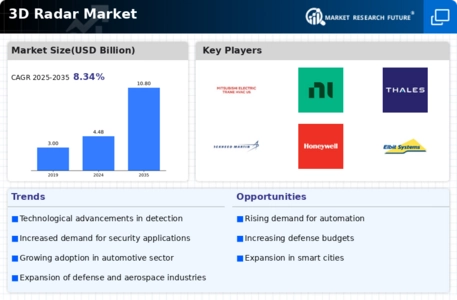Market Trends
Introduction
As we delve into the 3D Radar Market in 2023, several macro factors are significantly influencing its evolution. Technological advancements, particularly in signal processing and data analytics, are enhancing the capabilities of 3D radar systems, making them more efficient and versatile across various applications. Regulatory pressures, especially in defense and aviation sectors, are driving the adoption of advanced radar technologies to meet stringent safety and operational standards. Additionally, shifts in consumer behavior, with an increasing demand for real-time data and situational awareness, are propelling innovations in radar solutions. Understanding these trends is crucial for stakeholders, as they not only shape competitive strategies but also dictate investment priorities in a rapidly changing landscape.
Top Trends
-
Integration with AI and Machine Learning
The integration of AI and machine learning into 3D radar systems is enhancing target detection and tracking capabilities. For instance, military applications are leveraging these technologies to improve situational awareness, with reports indicating a 30% increase in detection accuracy. This trend is expected to drive operational efficiencies and reduce response times in defense operations, paving the way for more autonomous systems in the future. -
Miniaturization of Radar Systems
The trend towards miniaturization is making 3D radar systems more portable and versatile. Companies are developing compact radar units that can be deployed in drones and small vehicles, with some models weighing less than 10 kg. This shift is enabling broader applications in both military and civilian sectors, such as disaster management and surveillance, thus expanding the market reach significantly. -
Enhanced Signal Processing Techniques
Advancements in signal processing are improving the clarity and reliability of radar data. Enhanced algorithms are allowing for better noise reduction and target discrimination, which is crucial for applications in urban environments. This trend is being adopted by defense contractors, leading to more effective surveillance systems and potentially reducing operational costs by up to 20%. -
Increased Demand for Autonomous Systems
The rise of autonomous vehicles is driving demand for advanced 3D radar systems. Companies are investing in radar technologies that can provide real-time data for navigation and obstacle detection. This trend is expected to significantly impact the automotive industry, with projections indicating that autonomous vehicles will require sophisticated radar systems to ensure safety and efficiency. -
Focus on Cybersecurity in Radar Systems
As radar systems become more interconnected, the focus on cybersecurity is intensifying. Industry leaders are implementing robust security measures to protect against potential cyber threats, with a reported 40% increase in investments in cybersecurity for radar technologies. This trend is crucial for maintaining the integrity of defense systems and ensuring operational continuity in critical applications. -
Collaboration Between Defense and Commercial Sectors
There is a growing trend of collaboration between defense contractors and commercial technology firms to develop advanced radar solutions. This partnership is fostering innovation, with joint ventures leading to the creation of dual-use technologies that can serve both military and civilian markets. Such collaborations are expected to enhance product offerings and accelerate time-to-market for new radar systems. -
Adoption of 3D Radar in Smart Cities
The implementation of 3D radar technology in smart city initiatives is gaining traction. Cities are utilizing radar for traffic management and public safety, with studies showing a 25% reduction in traffic incidents in areas equipped with radar systems. This trend is likely to expand as urban areas seek to enhance safety and efficiency through advanced monitoring technologies. -
Development of Multi-Functional Radar Systems
The demand for multi-functional radar systems that can perform various tasks is on the rise. These systems are being designed to handle surveillance, tracking, and environmental monitoring simultaneously, which is appealing to both military and civilian users. This trend is expected to streamline operations and reduce costs associated with maintaining multiple radar systems. -
Regulatory Support for Advanced Radar Technologies
Governments are increasingly supporting the development of advanced radar technologies through favorable regulations and funding initiatives. For example, defense budgets are allocating more resources to radar research and development, with a reported increase of 15% in funding for innovative radar projects. This regulatory support is likely to accelerate technological advancements and market growth. -
Sustainability in Radar Manufacturing
Sustainability is becoming a key focus in the manufacturing of radar systems, with companies adopting eco-friendly materials and processes. This trend is driven by regulatory pressures and consumer demand for greener technologies, leading to a reported 20% reduction in carbon emissions in some manufacturing processes. Future developments may include fully recyclable radar components, enhancing the industry's environmental responsibility.
Conclusion: Navigating the 3D Radar Market Landscape
The 3D Radar market in 2023 is characterized by intense competitive dynamics and significant fragmentation, with both legacy and emerging players vying for market share. Regional trends indicate a growing demand in North America and Asia-Pacific, driven by advancements in defense and automotive applications. Vendors are strategically positioning themselves by leveraging capabilities in AI, automation, and sustainability, which are becoming critical differentiators in this evolving landscape. As companies prioritize flexibility in their offerings, those that can integrate these capabilities effectively will likely emerge as market leaders. Decision-makers must focus on aligning their strategies with these trends to capitalize on opportunities and navigate the complexities of this dynamic market.

















Leave a Comment